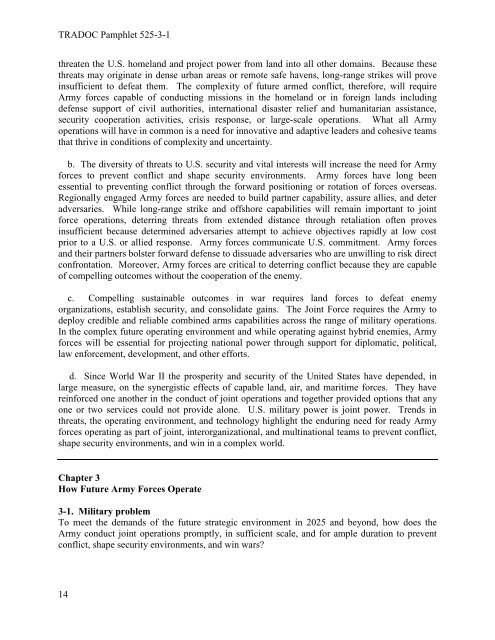TP525-3-1
TP525-3-1
TP525-3-1
You also want an ePaper? Increase the reach of your titles
YUMPU automatically turns print PDFs into web optimized ePapers that Google loves.
TRADOC Pamphlet 525-3-1<br />
threaten the U.S. homeland and project power from land into all other domains. Because these<br />
threats may originate in dense urban areas or remote safe havens, long-range strikes will prove<br />
insufficient to defeat them. The complexity of future armed conflict, therefore, will require<br />
Army forces capable of conducting missions in the homeland or in foreign lands including<br />
defense support of civil authorities, international disaster relief and humanitarian assistance,<br />
security cooperation activities, crisis response, or large-scale operations. What all Army<br />
operations will have in common is a need for innovative and adaptive leaders and cohesive teams<br />
that thrive in conditions of complexity and uncertainty.<br />
b. The diversity of threats to U.S. security and vital interests will increase the need for Army<br />
forces to prevent conflict and shape security environments. Army forces have long been<br />
essential to preventing conflict through the forward positioning or rotation of forces overseas.<br />
Regionally engaged Army forces are needed to build partner capability, assure allies, and deter<br />
adversaries. While long-range strike and offshore capabilities will remain important to joint<br />
force operations, deterring threats from extended distance through retaliation often proves<br />
insufficient because determined adversaries attempt to achieve objectives rapidly at low cost<br />
prior to a U.S. or allied response. Army forces communicate U.S. commitment. Army forces<br />
and their partners bolster forward defense to dissuade adversaries who are unwilling to risk direct<br />
confrontation. Moreover, Army forces are critical to deterring conflict because they are capable<br />
of compelling outcomes without the cooperation of the enemy.<br />
c. Compelling sustainable outcomes in war requires land forces to defeat enemy<br />
organizations, establish security, and consolidate gains. The Joint Force requires the Army to<br />
deploy credible and reliable combined arms capabilities across the range of military operations.<br />
In the complex future operating environment and while operating against hybrid enemies, Army<br />
forces will be essential for projecting national power through support for diplomatic, political,<br />
law enforcement, development, and other efforts.<br />
d. Since World War II the prosperity and security of the United States have depended, in<br />
large measure, on the synergistic effects of capable land, air, and maritime forces. They have<br />
reinforced one another in the conduct of joint operations and together provided options that any<br />
one or two services could not provide alone. U.S. military power is joint power. Trends in<br />
threats, the operating environment, and technology highlight the enduring need for ready Army<br />
forces operating as part of joint, interorganizational, and multinational teams to prevent conflict,<br />
shape security environments, and win in a complex world.<br />
Chapter 3<br />
How Future Army Forces Operate<br />
3-1. Military problem<br />
To meet the demands of the future strategic environment in 2025 and beyond, how does the<br />
Army conduct joint operations promptly, in sufficient scale, and for ample duration to prevent<br />
conflict, shape security environments, and win wars?<br />
14


